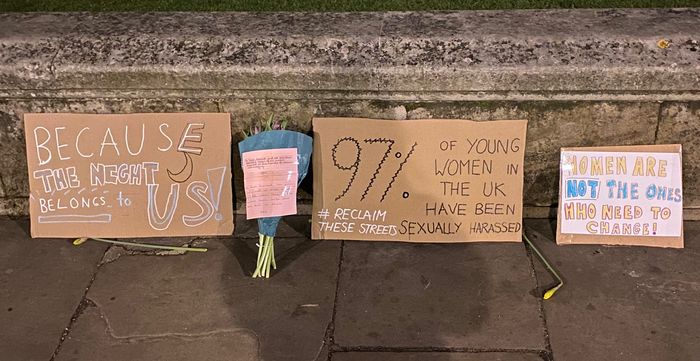Policing girls’ school uniform does not prevent sexual harassment, it perpetuates it
Helena DG argues that the way in which uniform is policed foregrounds inequalities rather than acting as an equaliser.

Content note: this article contains discussion of sexual misconduct and assault.
Having attended both single-sex and co-ed schools, I have encountered numerous uniform policies, ranging from compulsory blazers to a ban on bright hairbands. However, the rule which continuously caused the greatest stir was the insistence on knee-length skirts. Luckily, however, punishments were rare as most girls were accustomed to rolling their skirts down as quickly as they had been rolled up. Nevertheless, the constant focus on girls’ legs always irked me.
During the induction of how to walk to the school’s playing fields, there was less of a focus on being cautious of traffic than there was on the absolute necessity of wearing tracksuit bottoms on top of one’s skort — a necessity which I deemed to be unnecessary.
Building on this, I do not remember what sport we were meant to be playing the first time we walked to these fields. What I do remember is the trouble I (and a few others) got into for not wearing tracksuits upon arrival that first day as we were paraded as the example of ‘what not to do’ whilst an angry teacher wilfully shouted at us. At the time, I asked the teacher, ‘What’s the problem. They’re just legs’, — something which did little to resolve the problem, but resulted in gaining me a reputation as being subversive. Yet, I wasn’t trying to be subversive. I was just confused, trying to look for a rational explanation for the teacher’s irrational outburst.
“Whilst unable to articulate the misogyny when I was 11, the message of blame was unmissable at that point.”
After this incident I ended up succumbing; wearing tracksuits — pointless as it may be — was preferable to confrontation. Soon the issue was out of sight, out of mind. It was only then at my later school where the issue reemerged. Again, during an induction we were told not to wear “provocative” skorts around school for “our own protection”. Only upon hearing this years later, did I realise that my 11-year-old self had been right to confront that PE teacher. Whilst unable to articulate the misogyny when I was 11, the message of blame was unmissable at that point.
Hearing that a PE kit could be ‘provocative’ made me question why teachers were so provoked by it. It is in this way that uniform reveals gendered inequalities, as critiquing a girl’s skirt differs to telling students to tuck in their shirts — something which is not deemed provocative, and is not intrinsically linked with blame. Associating young girls’ clothes with sexuality and their safety is highly dangerous: not only does this place blame on victims, and fail to address the problem of gendered violence at its root, but it also roots violence by perpetuating a warped status quo.
In some UK schools, skirts are being outlawed in a purported move towards equality. Yet, what this is emblematic of, is women having to adjust their behaviour or dress in order to avoid wrongs for which they are not culpable. Whilst female safety continues to be a concern, it cannot be altered by forcing girls to change. Such alterations merely paper over the cracks and end up validating violence. The associated notions of blame form the foundation for why it was possible to dismiss a high-profile rape case in Peru due to the colour of a woman’s underwear. Thus, on top of failing to address rape culture, asking women to alter their behaviour exacerbates — not minimises — the risks they face.
“Whilst female safety continues to be a concern, it cannot be altered by forcing girls to change.”
A recent survey by UN Women UK revealed that 97% of women aged 18-24 had been sexually harassed. Though harassment should by no means be considered to be normal, it becomes normalised through authority figures, such as teachers. At school, I remember how a male teacher took it upon himself to wander the halls as the “uniform police”, peering through the glass panels by the door to see if there were any girls displaying too much leg. Once he identified his target, he would take great pride in pinpointing the problems of the girl’s uniform.
In hindsight, the thirteen-year-old girls were not the problem, he was. Yet, through his routine practice he normalised and institutionalised harassment by legitimising the idea that girls not only ought to be critiqued based on their appearance, but also shamed and blamed on account of the way in which their bodies are sexualised against their will.
The million-dollar question is why most skirts end up being shortened in the first place. Having asked various girls, the most common answer was, “it was the done thing” — something I cannot disagree with, as I fail to remember anyone who actually had a knee-length skirt. Yet, the reason it was the “done thing” is derived from social pressures; the very nature of the objectification of women means that women’s value is (mistakenly) derived from outward appearance.
Consequently, there is a greater focus on how women look, and pressure to conform to expectation. Thus, the semi-subconscious act of altering one’s uniform is rooted in sexist double standards; more often than not girls are not trying to break rules, but rather conform to what is expected of them. Ultimately, if everyone has a short skirt, you only stand out if yours is long. The criticism of short skirts thus highlights the binary of womanhood: damned if you do, and damned if you don’t. If you don’t shorten your skirt, you purportedly choose to single yourself out by defying gender norms. Equally, if you do shorten your skirt, you supposedly seek being sexualised. In both cases, the way in which girls dress is infiltrated by the male gaze, and becomes rife for criticism.
When I was 11 and did not wish to wear tracksuits over my skort, it was not because I was choosing to sexualise myself. Rather, it was my teachers who were sexualising me. To me, they were (and still are) ‘just legs’. Therefore, whilst uniform rules purportedly protect from sexual harassment, the enforcement of these very rules perpetuate and institutionalise harassment by dangerously legitimising a rhetoric of blame which allows students and teachers to sexualise girls’ bodies against their will.
Instead of backing girls into a cycle of victimhood and shame, it is about time to break the rules and evaluate the conditions which allow this cycle to exist in the first place.
 News / Clare Hall spent over £500k opposing busway 24 December 2025
News / Clare Hall spent over £500k opposing busway 24 December 2025 Comment / The ‘class’ of Cambridge24 December 2025
Comment / The ‘class’ of Cambridge24 December 2025 News / Caius mourns its tree-mendous loss23 December 2025
News / Caius mourns its tree-mendous loss23 December 2025 Comment / League tables do more harm than good26 December 2025
Comment / League tables do more harm than good26 December 2025 News / Girton JCR publishes open letter expressing solidarity with Palestine25 December 2025
News / Girton JCR publishes open letter expressing solidarity with Palestine25 December 2025









